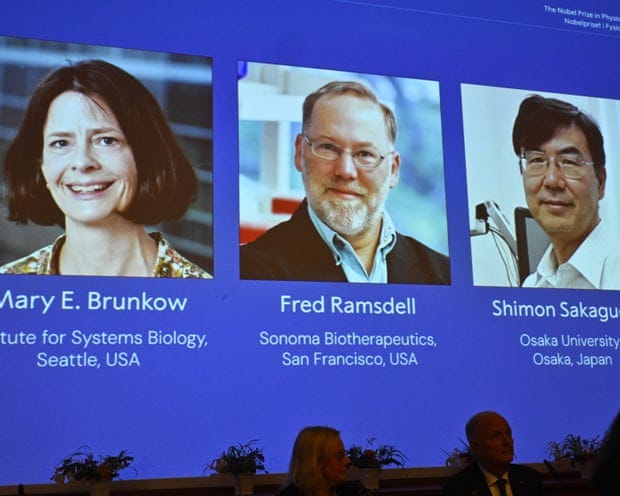They Won the 2025 Nobel in Medicine for Stopping Your Immune System From Fighting You
They Won the 2025 Nobel in Medicine for Stopping Your Immune System From Fighting You

He was in his lab in Osaka when his phone rang. The Nobel committee had announced that morning that Shimon Sakaguchi, Mary Brunkow, and Fred Ramsdell had won the 2025 Nobel Prize in Physiology or Medicine for unraveling how the body prevents its immune system from attacking itself. (They would share 11 million Swedish kronor, or about USD$ 1.2 million.)
Sakaguchi, to his delight, was the only one immediately reachable. The others may have had their phones on silent.
This award honors a discovery in the quiet corners of immunology that now may reshape how we treat diseases like type 1 diabetes and multiple sclerosis.
Think of your immune system as a vigilant guard. It learns to identify invaders and eliminate them. But mistakes happen. Some immune cells mistakenly flag your own tissue as foreign. Over decades, scientists understood that many of those harmful cells were eliminated during their training in a gland called the thymus; a process called central tolerance.
But what if some dangerous cells escaped that training? What then keeps them in check?
In 1995, Sakaguchi challenged the orthodoxy. He removed the thymus from newborn mice. The prediction was simple in that the risk of autoimmunity should be low, because any harmful T-cells should have been eliminated very early. Instead, the mice developed autoimmune damage. Something beyond the thymus must guard self from attack. From this, he inferred the existence of regulatory T cells, later known as T-regs.
These Tregs are the immune system’s brakes. They stop other T cells from running amok. But by themselves, they need direction. That guide turned out to be a gene named FOXP3.
This is where a mouse strain nicknamed “scurfy” comes in. These mice had fatal autoimmune disease. Their skin flaked and they died young. Researchers Mary Brunkow and Fred Ramsdell turned their attention to this strain. They discovered the culprit: a mutation on the X chromosome in the FOXP3 gene. The mutation disabled the formation of regulatory T cells, so nothing kept the immune system in check.
They then looked at humans with IPEX syndrome (Immune dysregulation, Polyendocrinopathy, Enteropathy, X-linked). Those children had mutations in the same gene. That made the connection real: FOXP3 is central to the development and function of Tregs. Without it, the immune system attacks its own body.
Then Sakaguchi brought the threads together. He showed that FOXP3 controls those regulatory T cells he had theorized years earlier. The immune system is not only policed by the thymus, but has second lines in the body (peripheral tolerance) mediated by Tregs.
These findings transformed immunology. The Nobel committee described their work as “decisive for our understanding of how the immune system functions and why we do not all develop serious autoimmune diseases.”
Now the race is on to harness Tregs medically. Over 200 clinical trials are underway, exploring therapies that increase regulatory T cells to calm autoimmune disease or reduce rejection in transplants.
Paradoxically, in cancer treatment the goal sometimes flips. Some tumors recruit Tregs to suppress immune attack. In those cases, reducing or disabling Tregs may allow the immune system to better target cancer cells.
Recently, a research team reprogrammed regulatory T cells by switching which version of FOXP3 they expressed. The reprogrammed cells behaved more like helper cells and helped tumor destruction.
Sakaguchi was born in 1951. He trained in medicine and immunology in Kyoto. He worked in the U.S. and Japan before returning to Osaka University, deeply probing how the immune system regulates itself.
Mary Brunkow, born in 1961, earned her PhD at Princeton in molecular biology. Fred Ramsdell studied microbiology and immunology at UCLA, earning his doctorate in 1987.
Ramsdell is a co-founder and scientific adviser at Sonoma Biotherapeutics, a biotech pushing engineered Treg therapies. The company celebrated his Nobel win, calling his FOXP3 work “seminal.”
There are no famous public controversies yet. The challenge is biological complexity and clinical translation. But with power comes scrutiny. Some ask: How safe is it to modulate Tregs? Will interfering with the brakes accidentally unleash new threats?
On the day of the announcement, Brunkow was awakened by her dog barking at a photographer on her Seattle porch. She learned she had won the Nobel while still waking up.
At an Osaka press conference, Sakaguchi took a congratulatory call from Japan’s prime minister, who asked how this might reshape cancer treatment. With a measured tone, Sakaguchi answered that more work lies ahead before impact on patients.
In Stockholm, Thomas Perlmann, secretary of the medicine committee, joked he had only managed to reach Sakaguchi by phone — the others might have had their phones off.
These events are small — calls, startled mornings — but they reveal something deeper: that science is human. Labs are full of failures, doubts, late nights. These discoveries took decades and persistence beyond trend.
Autoimmune diseases like type 1 diabetes and multiple sclerosis cause immense suffering. If we can reinforce regulatory T cell function, we may suppress these illnesses. Organ transplants may fare better if the body’s immune system is less reactive. Cancer therapy may be smarter if we can disable the Treg support tumors exploit.
Because of these discoveries, modern immunology has a new toolkit. But translation is tricky. Trials must monitor safety. Tregs are part of a delicate balance. Too few and autoimmunity emerges, too many and immune surveillance suffers.
The Nobel committee honored a concept that will reverberate for decades. They awarded early insight over flashier breakthroughs. These scientists revealed the immune system’s hidden guardrails.
If we look back in 20 years, some current trials will succeed, others will fail. That is how science advances. But today, we celebrate the moment when three researchers quietly redefined how our bodies tell friend from foe.

